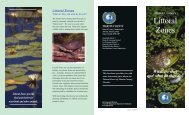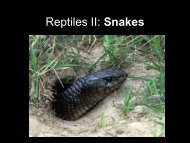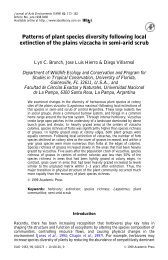plants. The overall goal of the project is to develop a reliable genetic database used to delineate <strong>and</strong> determine thesource of sea oats to ensure ecologically sound beach <strong>and</strong> dune restoration. Ultimately, plant micropropagationtechnology <strong>and</strong> cryopreservation will be used to create a germplasm library of multiple genotypes from each majorsea oats population. This both ensures a long-term reserve of population specific genotypes for beach <strong>and</strong> dunerestoration.OBJECTIVES: To establish a germplasm library of sea oats genotypes from all major populations along <strong>Florida</strong>’s Atlantic<strong>and</strong> Gulf coasts. To determine the genetic diversity <strong>and</strong> distance of seedlings collected from the major sea oats populationsalong the <strong>Florida</strong> Gulf <strong>and</strong> Atlantic coasts using AFLP fingerprinting procedures. To evaluate use of the sea oats diversity genetic database as a tool to delineate sea oats provenance distancealong <strong>Florida</strong>’s Atlantic <strong>and</strong> Gulf coasts.PROGRESS:All immediate objectives have been accomplished. Sea oats seed was harvested from sixteen <strong>Florida</strong> State Parks orRecreation Areas: Perido Key, Navarre Beach, Henderson Beach, St. Andrews, St. George, Little Talbot Isl<strong>and</strong>,Anastasia, Gamble Rogers, Honeymoon Isl<strong>and</strong>, Sebastian Inlet, John D. MacArthur, Don Pedro Isl<strong>and</strong>, Delnor-Wiggins Pass, John U. Lloyd, <strong>and</strong> Bill Braggs Cape <strong>Florida</strong>. Park managers <strong>and</strong> biologists were consulted to assurethat seed was only harvested from areas that had not been replanted. Seed production varied significantly betweenpopulations. Seed was surfaced sterilized in a three-step process <strong>and</strong> germinated in vitro on Murashige & SkoogMedium in 150 X 25 mm glass culture tubes. We found that germination could be significantly enhanced bymaintaining the culture tubes on a heating mat at about 37 C. In vitro germination rates <strong>and</strong> seedling growth variedconsiderable between the sea oats populations <strong>and</strong> genotypes. We have now completed establishment of seedcultures from all sea oats the populations sampled. These data are being analyzed to determine if there are anypopulation specific differences in germination <strong>and</strong> initial seedling growth. To establish clonal lines, unbranched 7-week old seedlings were transferred to sea oats shoot multiplication medium.______________________________Determination of Population Diversity in the <strong>Florida</strong> EndangeredOrchid Cyrtopodium punctatumPrincipal Investigator: Michael E. KaneFunding Agencies: U.S. Department of Interior, USGSExpected Completion: 9/30/2010 (RWO 251, UF#77491)Cytopodium punctatum, the cigar orchid, is an endangered plant in the state of <strong>Florida</strong>. The species distributionranges from <strong>Florida</strong> <strong>and</strong> the West Indies. The genus Cyrtopodium comprises about 35 species, with C. punctatumbeing the only epiphytic member <strong>and</strong> northernmost ranging species. Cyrtopodium punctatum is a very large showyorchid that bears showy flowers. Due to its appeal, the species was over collected during the past century <strong>and</strong> todayonly a few plants still exist in inaccessible <strong>and</strong> protected areas. Three distinct populations are located in <strong>Unit</strong> 51 (ca.7 plants), 54 ca. 14 plants) <strong>and</strong> an 3 plants in <strong>Unit</strong> 38 at the <strong>Florida</strong> Panther National <strong>Wildlife</strong> Refuge (FPNWR;Collier Co., FL). With previous funding from the FPNWR, a seed propagation protocol has been developed for thefuture reintroduction of C. punctatum. Breeding system type is one of the most important determinants of the geneticcomposition of plant populations. Consequently, pollination biology <strong>and</strong> breeding system studies are beingcompleted in two FPNWR C. punctatum populations to underst<strong>and</strong> the ecology <strong>and</strong> population genetics of thisspecies in situ. However, the current genetic diversity <strong>and</strong> structure in the FPNWR C. punctatum populations is notknown. This information is critical for development of ecologically sound integrated conservation plans.OBJECTIVES OF PROJECT: Determine genetic diversity of C. punctatum populations in the FPNWR. Compare genetic diversity between <strong>and</strong> within C. punctatum populations Interpret results in light of ongoing reintroduction efforts with this species.34
OBJECTIVES YR 1: Determine genetic diversity of C. punctatum populations in the FPNWR.TASKS: Leaf samples from newly developed leaves will be collected from all known plants throughoutthe FPNWF (totaling about 20 plants). DNA will be extracted using DNeasy Plant Mini Kits. PurifiedDNA will be subjected to Amplified Fragment Polymorphism (AFLP)analysis.OBJECTIVES YR 2: Compare genetic analysis between <strong>and</strong> within C. punctatum populations.TASKS: Analyze AFLP data using GeneMarker software, Use POPGENE software to estimate fixationindexes (F IS , F IT , <strong>and</strong> F ST ), effective population size (N m ), H O , <strong>and</strong> expected Nei’s <strong>and</strong> Shannon’sheterozygosity estimates (H E ). Use the program STRUCTURE v 2.2 for population assignment <strong>and</strong>principle coordinate analysis of data. Intepret results with respect to development of a ecologically-soundre-introduction program.PROGRESS 2009:A site visit was made to the FPNWR on December 2, 2008 to discuss sampling procedures with Larry Richardson.Since newly developed leaves of C. punctatum are required for “clean” DNA extraction, sampling will not beginuntil late March 2009 when new leaves on the donor plants will available. A site visitation with Larry Richardsonwas made on March 17, 2009 to identify the locations of the individual plants from which tissue samples will betaken for DNA analysis. Plants were just beginning to flower. The DNA extraction kits have been ordered <strong>and</strong>arrangements were made to work in the laboratory of Dr. Charles Guy to perform the DNA extractions. Variousmethods are being compared to decide which method to use to store the plant tissues prior to DNA extraction.______________________________Techniques for Field Establishment <strong>and</strong> Reintroduction ofCalopogon tuberosus Var. tuberosusPrincipal Investigator: Michael E. KaneCo-Principal Investigator: Philip J KauthFunding Agencies: U.S. Department of Interior, FWSExpected Completion: 8/30/09 (UF#69941)While much of the literature regarding orchids focuses on propagationtechniques, little information exists on reintroduction, trans-location, <strong>and</strong>field transplanting. Habitat destruction or degradation is responsible forloss of orchid habitat <strong>and</strong> orchid populations. Reintroduction of seedlingsinto natural habitats is becoming a popular technique for conservation, butfield-establishment often fails. Much of the information regarding reestablishmentfocuses on seedlings. A major obstacle to fieldestablishment is initial survival. Only a few articles discuss techniques forincreasing survival of orchid seedlings. One technique used to increasesurvival is planting dormant storage organs such as tubers or corms.Calopgon tuberosus in the FL PantherNational <strong>Wildlife</strong> RefugeCalopogon tuberosus var. tuberosus is a cormforming species found throughout eastern NorthAmerica includingsouthwest <strong>Florida</strong>. In south <strong>Florida</strong>, this species has up to ten magenta flowers that open in succession. Theflowering season begins in April <strong>and</strong> continues through the end of May in south <strong>Florida</strong>. Seed capsules are fullyripe approximately 6-8 weeks after pollination. Reintroduction of Calopogon tuberosus to suitable habitats is thenext logical step in a propagation experiment. We have successfully germinated seeds of C. tuberosus to theseedling stage, <strong>and</strong> have successfully grown seedlings from other populations under greenhouse conditions.35


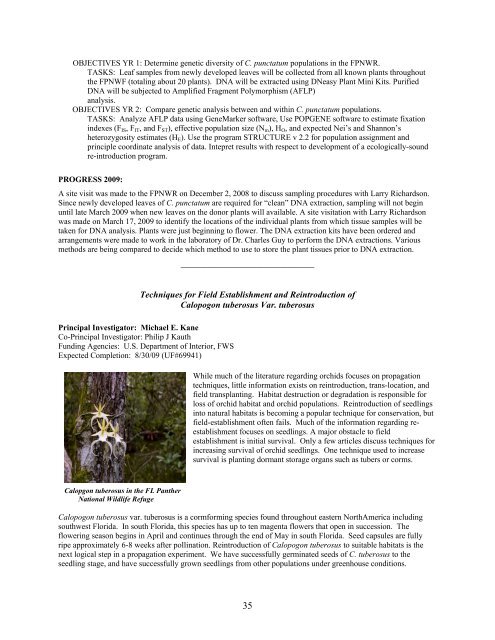
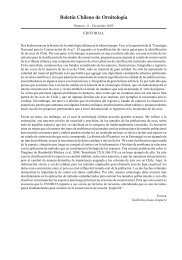
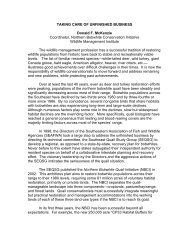
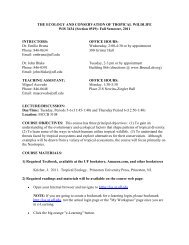
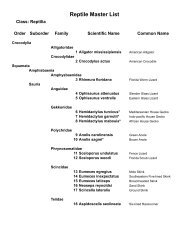

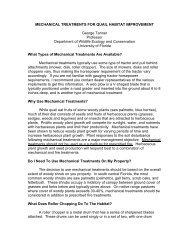
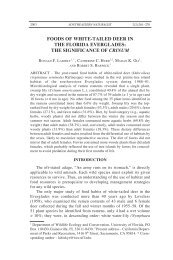
![rivers,lakes.ppt [Read-Only]](https://img.yumpu.com/43445703/1/190x245/riverslakesppt-read-only.jpg?quality=85)
